Track and Street Furniture
Trams require track and overhead power cables to operate. When trams
cease to operate, it may take many years before these visible signs finally
disappear.
At first the power cables will be taken down, but the traction poles which
carried them may be left in place. They are more difficult to remove and can
often converted for other uses such as street lighting. In this way, it is
still sometimes possible to find tramway traction poles by the side of former
tram routes.
Tram stop plates can also be reused. In Coventry, they were the same shape as bus
stop plates. It was a simple and cost-effective job to take them down, repaint
them as bus stops and put them up again elsewhere. It was impossible to tell,
except if the paint began to peel off to reveal the older wording underneath!
Tram tracks are more troublesome to remove than traction poles. They were
often laid in the centre of roadways and embedded some way down. It was often
easier just to tarmac over the track. Very often, redundant tramtrack only
comes to light many years after it was last used, as a result of a major road
project. In Coventry, this was the case on several occasions from the 1960's
right through to the early 1980's.
The construction of the inner ring road unearthed major trackworks at the
junction of Jesson Street (now gone), Hales Street and Ford Street. This is
approximately where Hales Street meet the slip road from the ring road flyover.
Other such discoveries have occured in Queens Road, Warwick Road outside 'The Litten
Tree' (formerly 'Intershop' and before that 'Benleys'),
by the Coventry Theatre and outside the old Fire Station in Hales Street. In
some cases, the track was removed as part of the road works whilst on other
occasions, it was covered over again when the road was resurfaced.
|

|
This green painted column at the junction of Stoney Stanton Road and Cross Road
is possibly a redundant traction pole. No photgraph could be found of a tram at
this point to confirm it's use. However, other photographs of Coventry trams
show traction poles similar in appearance to this. It is certainly the correct
colour as traction poles were painted green from the 1930's.
|
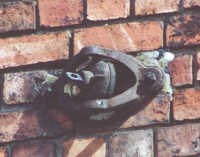
|
As well as traction poles, overhead power cables were also carried on span wires running
between buildings on either side of the tramway. They were attached by means of cast
iron rosettes. These may also remain in place for many years as their removal for scrap
may not be cost effective. However, in Coventry where they were mainly used in the centre,
only one is known to remain. This is because the wartime blitz and postwar redevelopment
have swept away many of the buildings to which they were attached.
|
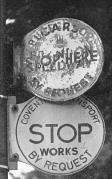
|
The bus stop plate at the top of this picture was formerly a tram stop. It is
just possible to make out the wording 'CARS STOP HERE BY REQUEST'. It was still
in used at Gosford Green in the early 1970's. The plate was removed shortly
afterwards. All bus and trams stop plates were used by Coventry Corporation
were round until the 1960's. No Coventry bus stop plates of any description
are believed to still be in use.
|
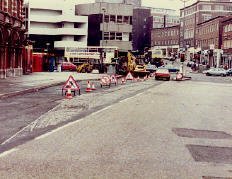
|
These two pictures show the road before resurfacing outside the old Fire
Station in Hales Street during October 1983. This tram track was subsequently
covered over again.
|
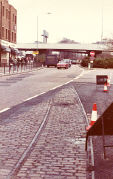
|
|
These pictures show the same track uncovered again during work on
the Phoenix Project during summer 2002. Some of the track has
now been removed and the rest may never be seen again.
|
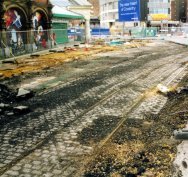
|
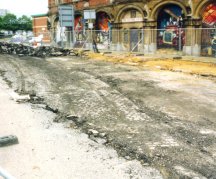
|
|